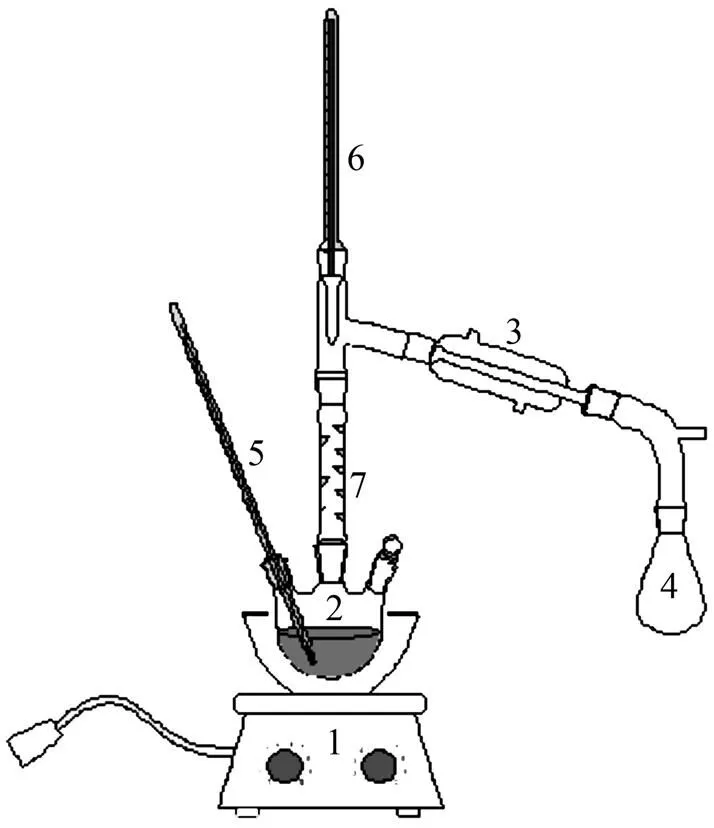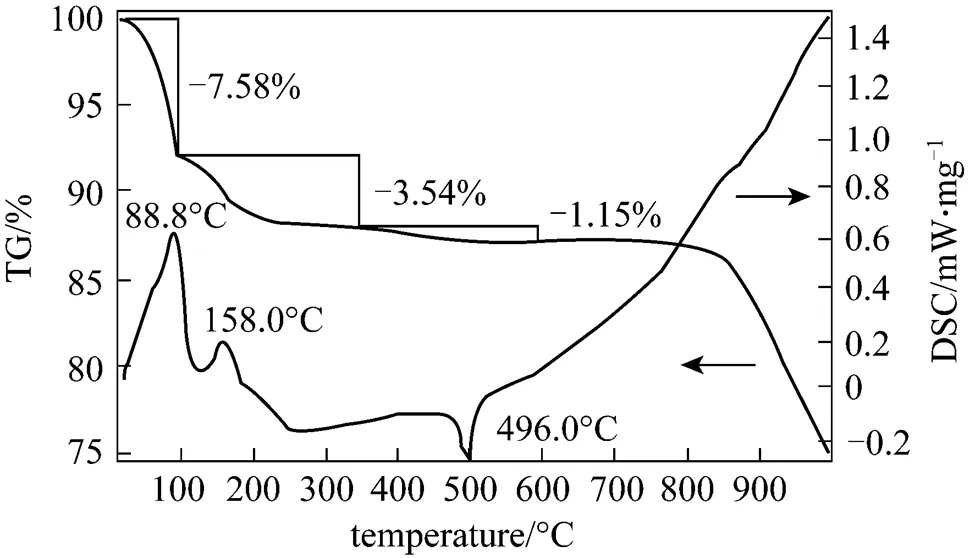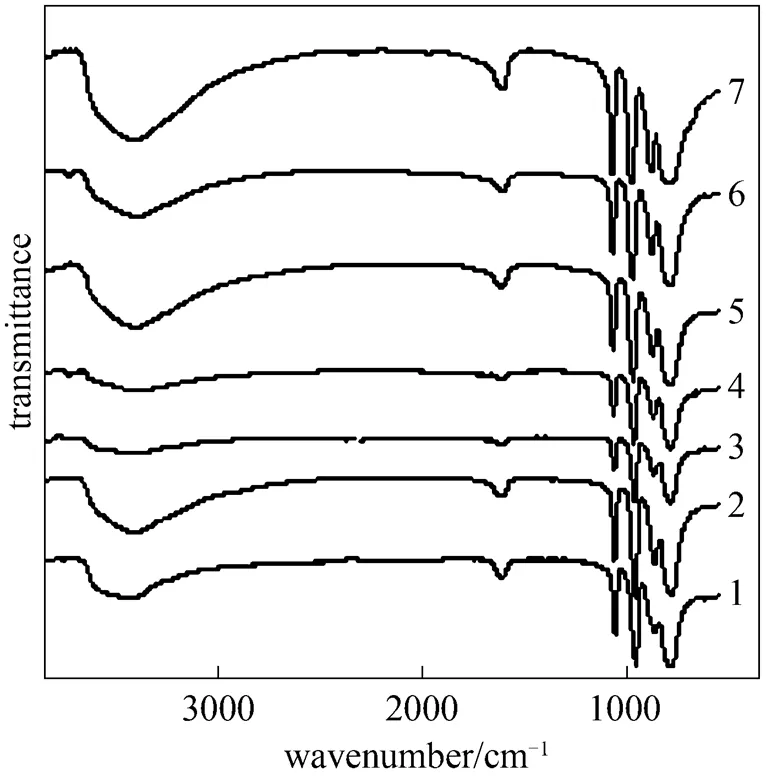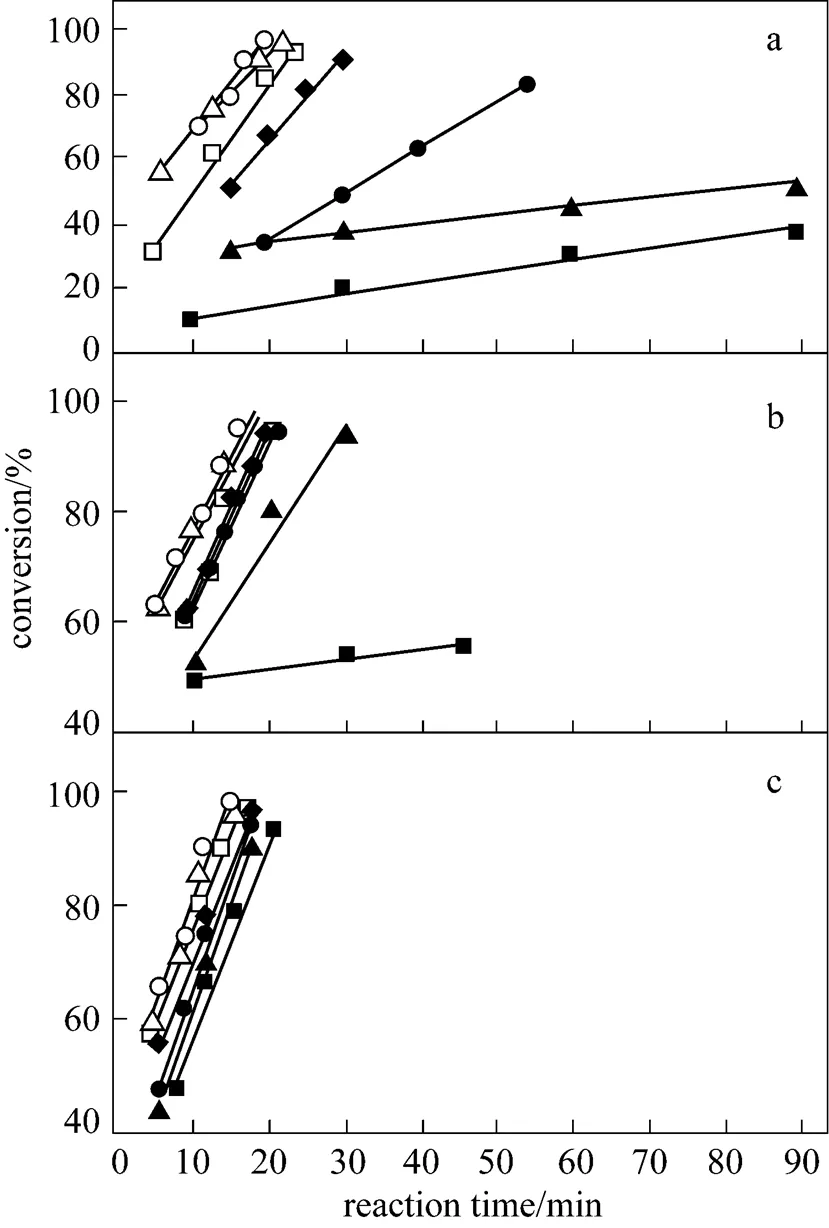Preparation and Characterization of Tungsten-substituted Molybdophosphoric Acids and Catalytic Cyclodehydration of 1,4-Butanediol to Tetrahydrofuran*
WU Huixiong (吳慧雄), ZHOU Mei (周梅), QU Yixin (屈一新),**, LI Haixia (李海霞) and YIN Hengbo (殷恒波)
?
Preparation and Characterization of Tungsten-substituted Molybdophosphoric Acids and Catalytic Cyclodehydration of 1,4-Butanediol to Tetrahydrofuran*
WU Huixiong (吳慧雄)1, ZHOU Mei (周梅)1, QU Yixin (屈一新)1,**, LI Haixia (李海霞)2and YIN Hengbo (殷恒波)2
1Faculty of Chemical Engineering, Beijing University of Chemical Technology, Beijing 100029, China2Faculty of Chemistry and Chemical Engineering, Jiangsu University, Zhenjiang 212013, China
A series of tungsten-substituted molybdophosphoric acids (H3PMo12-nWO40·H2O) were synthesized and characterized by inductive coupled plasma atomic emission spectroscopy (ICPAES), thermal gravimetry and differential scanning calorimetry (TG-DSC), Fourier transform infrared spectroscopy (FTIR), X-ray diffraction (XRD), and FTIR pyridine adsorption. The as-prepared heteropoly acids have a Keggin type structure. The synthesis of tetrahydrofuran by reactive distillation and cyclodehydration of 1,4-butanediol was studied using the tungsten- substituted molybdophosphoric acids as catalysts. The results of catalytic test indicated that the catalytic activity increased with the increase in the substitution number () of tungsten atom in H3PMo12-nWO40·H2O and was constant as the substitution number () was more than 8. The catalytic activity increased with the increase in the catalyst loading and the selectivity of tetrahydrofuran was nearly 100%.
tungsten-substituted molybdophosphoric acid, 1,4-butanediol, tetrahydrofuran, reactive distillation
1 INTRODUCTION
Tetrahydrofuran is a widely used solvent in the production of polyvinyl chloride (PVC) cements and coatings, pharmaceuticals, magnetic tapes and films, and in Grignard reactions. Tetrahydrofuran is also widely used as a precursor for polyurethanes and elastic fibers [1]. The majority of tetrahydrofuran is produced by the Reppe process [1-3], wherein tetrahydrofuran is produced directly from the mineral acid-catalyzed cyclodehydration of 1,4-butanediol. However, traditional strong protonic mineral acids have many disadvantages, such as corrosivity, toxicity, and difficult separation from reaction solution. The development of an eco-friendly and effective catalyst for cyclodehydration of 1,4-butanediol to tetrahydrofuran has recently attracted researchers’ interest.

Recently, the Keggin type heteropoly acids have received increasing attention and were shown to perform well in a variety of acid-catalyzed reactions, such as alkylation of benzene [7] and-cresol [8], esterification of isoamyl alcohol and acetic acid [9], lactonization of 1,4-butanediol [10], and cyclodehydration of 1,4-butanediol [11]. The advantages of the Keggin type heteropoly acid catalysts are the low volatility, low corrosivity, non-toxicity, high Br?nsted acid strength (approaching the superacidic region and greater than that of conventional solid acids, such as zeolites and mixed oxides), and high activity and selectivity for several reactions when compared with conventional homogeneous acids (.. H2SO4, AlCl3, ZnCl2and BF3) [7, 9, 12-16].
The catalytic properties of heteropoly acids can be tuned by changing their central heteroatoms, framework polyatoms, and charge-compensating counter cations because the substitution of these atoms changes their acid and redox properties [15-18]. For example, as compared with molybdophosphoric acid, vanadium- substituted molybdophosphoric acids showed high activity and selectivity for the lactonization of 1,4-butanediol to γ-butyrolactone [10], the oxidation of methacrolein to methacrylic acid [18], the oxidation of isobutene to methacrylic acid and methacrolein [19], the oxidation of nitrobenzene to nitrophenol [20], and the oxidation of benzene to phenol [21]. Tungsten- substituted molybdophosphoric acids showed higher catalytic activity for the oxidation of cyclopentene to glutaraldehyde [22] and the epoxidation of cyclopentene [23] than molybdophosphoric acid. Furthermore, the substitution extent also affected catalytic activity [10, 18-20, 22-24].
It is well known that the acid strength of tungstophosphoric acid is higher than that of molybdophosphoric acid [16, 25]. Therefore, it can be predicted that replacement of molybdenum by tungsten in the peripheral metal atom positions of the anions can increase the acid strength of the heteropoly acids, giving high catalytic activity for acid-catalyzed reactions.
Heteropoly acids are non-porous materials in the solid state with surface area below 10 m2·g-1and only a few acid sites present on the surface are available when non-polar molecules reacted. But heteropoly acids are highly soluble in polar solvents, beneficial by supplying more acid sites, and catalyzing the reaction homogeneously [14, 26]. At the same time, a drawback occurs in the separation of the heteropoly acid from polar reaction system. In order to immobilize heteropoly acid and to supply more acid sites, the conventional method is to support heteropoly acid on porous substrates. Unfortunately, the amount of acid sites decreased when the interaction between support (.. Al2O3) and heteropoly acid is strong or the loading of heteropoly acid is low. In contrast, leaching of the supported heteropoly acid into the reaction mixture inevitably occurs while the interaction between supports (.. SiO2, MCM-41, and activated carbon) and heteropoly acid is weak or the loading of heteropoly acid is high [12, 15, 16, 26-28]. Considering that the reactant and products can be easily separated by reactive distillation in the cyclodehydration of polar 1,4-butanediol to tetrahydrofuran [11], homogeneous reactive distillation technique should be beneficial to the cyclodehydration of 1,4-butanediol to tetrahydrofuran when heteropoly acids are used as catalysts because of the advantages in the accessibility of acid sites, the economization of energy, and the positive shift of chemical reaction.
In our present work, a series of tungsten-substituted molybdophosphoric acids (H3PMo12-nWO40·H2O) were prepared by a modified classical ether extraction method and the reactive distillation cyclodehydration of 1,4-butanediol to tetrahydrofuran catalyzed by tungsten-substituted heteropoly acids were investigated.
2 EXPERIMENTAL
2.1 Preparation of H3PMo12-nWnO40·xH2O
The chemicals, such as Na2WO4·2H2O, Na2MoO4·2H2O, Na2HPO4·12H2O, H2SO4(98%), and diethyl ether, were purchased from Shanghai Chemical Co. All chemicals were of analytical grade and were used without further purification. Distilled water was used in all the experiments.
The heteropolyacids were prepared by a modified classical ether extraction method. The preparation of a tungsten-substituted molybdophosphoric acid with a desired formula of H3PMo11WO40·H2O is presented as an example: 8.95 g of Na2HPO4·12H2O and 66.54 g of Na2MoO4·2H2O were dissolved in 50 ml and 100 ml of distilled water, respectively. The above-mentioned solutions were mixed and heated at 90°C for 30 min under constant stirring. Then, 50 ml aqueous solution containing 8.25 g of Na2WO4·2H2O was added to the above mixed solution. The pH value of the solution was adjusted to 1.5-2 by adding 98% H2SO4dropwise under vigorous stirring. The reaction was carried out at 90°C for 8 h under stirring. After reaction, the solution was cooled to room temperature over night. 100 ml of diethyl ether was added into the solution with intense thorough shaking to extract the resultant heteropolyacid. The coarse tungsten-substituted molybdophosphoric acid was re-crystallized.

2.2 Characterization
The bulk elemental composition of the as-prepared tungsten-substituted molydophosphoric acids was examined by inductive coupled plasma atomic emission spectroscopy (ICPAES) (VISTA-MPX CCD simultaneous ICP-AES). Thermal gravimetry and differential scanning calorimetry (TG-DSC) curves of the samples were acquired using a thermoanalysis instrument (NETZSCH STA 449C) under dynamic nitrogen atmosphere at a heating rate of 10°C·min-1. Fourier transform infrared spectra (FTIR) of the samples were recorded on a Nicolet-Nexus 470 FTIR spectrometer at room temperature using the KBr pellet technique. Powder X-ray diffraction analysis was carried out on a Shimada DX-D1 powder diffractometer using Cu Kαradiation at a wavelength of 0.154 nm, 30 kV, and 30 mA. The acidic properties of the samples were characterized by FTIR spectroscopy with chemisorbed pyridine. For the measurement of the FTIR pyridine adsorption spectra, the wafers were mounted in an infrared vacuum cell, exposed to pyridine vapor for 0.5 h, and then degassed at 25°C for 8 h under vacuum (<10-3Pa).
2.3 Catalytic test
Catalytic cyclodehydration of 1,4-butanediol to tetrahydrofuran was carried out in a 250 ml of pyrex flask with 100 ml of 1,4-butanediol and 7.5×10-5, 2.27×10-4, and 3.78×10-4mol of tungsten-substituted molybdophosphoric acids (H3PMo12-nWO40·H2O) as catalysts, respectively, at boiling state under atmospheric pressure. The catalyst was added into 1,4-butanediol solution when 1,4-butanediol was heated to its boiling point (230°C), and an external electric heater was used as a heating source whose temperature was maintained at 400°C during all of the catalytic test processes in order to avoid the effect of heating rate on the catalytic activity. Reactive distillation technique was used to separate the produced tetrahydrofuran and water from the reaction system. The reactive distillation apparatus was illustrated in Fig. 1. The reaction products, tetrahydrofuran and water, were rapidly separated from the reaction system by a spiniform distillation column and condensed with a condenser. To effectively separate the products and the reactant, the length of the spiniform distillation column was of 15 cm. The product analysis was carried out by gas chromatography with a capillary column (30 m×0.25 mm) packed with polyethylene glycol (PEG), 20 m, using a flame ionization detector. The column temperature was maintained at 140°C for 6 min and then, raised to 210°C at a heating rate of 10°C·min-1.

Figure 1 Reaction apparatus
1—electric heater; 2—reactor; 3—condenser; 4—product collector; 5, 6—thermometers; 7—spiniform distillation column
3 RESULTS AND DISCUSSION
3.1 Characterization of tungsten-substituted molybdophosphoric acids
3.1.1
The main element contents of the tungsten- substituted molybdophosphoric acids analyzed by ICPAES are listed in Table 1. ICPAES analysis indicated that the mole ratios of P︰Mo︰W of the samples had a little deviation from the desired ones. Although the as-prepared tungsten-substituted molybdophosphoric acids were of a Keggin type as certified by XRD and FTIR analyses in the following sections, the mole ratio deviation revealed that the Keggin type structure of the samples was a little distorted.

Table 1 Main element contents, TG-DSC results, and formulas of the as-prepared tungsten-substituted molybdophosphoric acids
3.1.2
The contents of water present in the tungsten- substituted molybdophosphoric acids were analyzed by TG-DSC technique. The TG-DSC analysis of the sample with a mole ratio of P︰Mo︰W being 1︰4.8︰6.8 was taken as a representative example. As shown in Fig. 2, in the first mass-loss stage, free crystallized water, 7.58% of the total sample mass, was lost and an endothermic peak correspondingly emerged at 88.8°C. The H+-combined water, 3.54% of the total sample mass, was lost in the second mass-loss stage accompanied by an endothermic peak at 158°C. In the third mass-loss stage, the structural water, 1.15% of the total sample mass, was lost and an exothermic peak at 496°C appeared in DSC curve, characterizing the collapse of the heteropoly acids [29, 30]. With the TG-DSC and ICPAES results, the formula of the sample was determined as H3PMo4.8W6.8O40·15H2O.

Figure 2 TG-DSC curves of the sample with a mole ratio of P︰Mo︰W being 1︰4.8︰6.8
For all of the as-prepared tungsten-substituted molybdophosphoric acids, there were two endothermic peaks and one exothermic peak in the DSC curve of each sample, correspondingly accompanied by three stages of mass loss in the TG curve. According to the TG-DSC and ICP analyses, the formulas of the tungsten-substituted molybdophosphoric acids were calculated and listed in Table 1.
As shown in Table 1, the temperatures of the second endothermic peaks, corresponding to the mass loss of H+-combined water, increased from 116.7 to 169.1°C, while the tungsten atom number in the formulas increased from 0 to 10.6. It is well known that when the desorption temperature of the H+-combined water is high, the acid strength is high [24, 31]. Therefore, an increase of tungsten content in the tungsten-substituted molybdophosphoric acids raises their acid strength.
3.1.3

The bands at ca. 1610 cm-1and 3440 cm-1attributed to the bending and stretching vibrations of crystallized water [35, 36] were present in all of the FTIR spectra, revealing that the resultant tungsten- substituted molybdophosphoric acids were hydrated.
3.1.4
As shown in Fig. 4, the X-ray diffraction patterns of the tungsten-substituted molybdophosphoric acids are primarily distributed in four ranges of 2, which are 6o-12o, 16o-23o, and 25o-30o, revealing that the synthesized samples belong to the set of Keggin type heteropoly acids [26, 35]. XRD pattern of a heteropoly acid reflects its secondary structure, which strongly depends on its environments. The variation in the intensities of the sample diffraction peaks should be due to the framework polyatom substitution and the hydration.
3.1.5
To characterize the surface acidity of solid catalyst, adsorption of pyridine as a base on the solid surface is widely used. The adsorbed pyridine is frequently analyzed by IR spectroscopy to distinguish the different acid sites [7, 8, 14, 15, 37]. FTIR pyridine adsorption spectra of the tungsten-substituted molybdophosphoric acids are shown in Fig. 5. After the adsorption of pyridine, two new bands at ca. 1485 cm-1and 1536 cm-1were observed in the IR spectra of all of the samples. The adsorption band at 1536 cm-1is attributed to the pyridinium ion formed at Br?nsted acid sites [7, 15, 37]. The band at 1485 cm-1is a combined band originating from pyridine bonded to Br?nsted and Lewis acid sites [8, 14]. The characteristic band at ca.1444 cm-1of pyridine molecules adsorbed at the Lewis acid sites [7, 15, 37] was not found in the FTIR spectra of all of the samples, indicating that there are no Lewis acid sites present in the as-prepared samples. The as-prepared tungsten-substituted molybdophosphoric acids only have Br?nsted acid sites.

Figure 3 FTIR spectra of the heteropoly acids
1—H3PMo12O40·12H2O; 2—H3PMo10.6W1.1O40·22H2O; 3—H3PMo8.7W3O40·19H2O; 4—H3PMo6.5W4.8O40·12H2O; 5—H3PMo4.8W6.8O40·15H2O; 6—H3PMo3.3W8.5O40·11H2O; 7—H3PMo1.2W10.6O40·12H2O

Figure 4 X-ray diffraction patterns of the heteropoly acids
1—H3PMo12O40·12H2O; 2—H3PMo10.6W1.1O40·22H2O; 3—H3PMo8.7W3O40·19H2O; 4—H3PMo6.5W4.8O40·12H2O; 5—H3PMo4.8W6.8O40·15H2O; 6—H3PMo3.3W8.5O40·11H2O; 7—H3PMo1.2W10.6O40·12H2O

Figure 5 FTIR pyridine adsorption spectra of the heteropoly acids
1— H3PMo12O40·12H2O; 2—H3PMo10.6W1.1O40·22H2O; 3—H3PMo8.7W3O40·19H2O; 4—H3PMo6.5W4.8O40·12H2O; 5—H3PMo4.8W6.8O40·15H2O; 6—H3PMo3.3W8.5O40·11H2O; 7—H3PMo1.2W10.6O40·12H2O

Table 2 FT-IR data of H3PMo12-nWnO40·xH2O
3.2 Catalytic activity test
Reactive distillation technique was used in the catalytic cyclodehydration of 1,4-butanediol to tetrahydrofuran in order to separate the products, tetrahydrofuran and water, from the reaction system. As the products were only tetrahydrofuran and water,.., the selectivity of the tetrahydrofuran was nearly 100%, the variation of the conversion of 1,4-butanediol with the reaction time and the catalyst loading was used as the criteria to evaluate the catalytic activity of the tungsten-substituted molybdophosphoric acid. The catalytic activities of the as-prepared heteropoly acids are shown in Fig. 6.
When the loadings of the heteropoly acids, such as H3PMo12O40·12H2O, H3PMo10.6W1.1O40·22H2O, H3PMo8.7W3O40·19H2O, H3PMo6.5W4.8O40·12H2O, H3PMo4.8W6.8O40·15H2O, H3PMo3.3W8.5O40·11H2O, and H3PMo1.2W10.6O40·12H2O, were 7.5×10-5mol, the conversions of 1,4-butanediol were 37.6%, 51.8%, 83.3%, 90.7%, 92.9%, 96.5%, and 96.6% after reaction for 90, 90, 55, 30, 24, 22, and 20 min, respectively.When the loadings of the heteropoly acids to 2.27×10-4mole were increased, the conversions of 1,4-butanediolwere 56%, 93.5%, 93.8%, 94%, 94%, 96%, and 94.8% after reaction for 45, 30, 21, 20, 19, 18, and 16 min, respectively. With furthermore increase of the loadings of the heteropoly acids to 3.78×10-4mol, the conversions of 1,4-butanediol were 92.9%, 90.2%, 94.2%, 96.2%, 96.6%, 96.3%, and 97.8% after reaction for 21, 18, 18, 18, 17, 15, and 15 min, respectively.

Figure 6 Catalytic activity of the heteropoly acids in the cyclodehydration of 1,4-butanediol to tetrahydrofuran
catalysts amounts/mol: (a) 7.5×10-5; (b) 2.27×10-4; (c) 3.78×10-4■?H3PMo12O40·12H2O; ▲?H3PMo10.6W1.1O40·22H2O; ●?H3PMo8.7W3O40·19H2O; ◆?H3PMo6.5W4.8O40·12H2O; □?H3PMo4.8W6.8O40·15H2O; △?H3PMo3.3W8.5O40·11H2O; ○?H3PMo1.2W10.6O40·12H2O
The catalytic results showed that the catalytic activity increased with the increase of the catalyst loading and with the prolonging of the reaction time. It is worth noting that the catalytic activity of the tungsten- substituted molybdophosphoric acid was significantly enhanced by increasing the content of the tungsten present in the heteropoly acid, especially at a low catalyst loading. The increase of the catalytic activity with the increase in the tungsten content in the heteropoly acid can be explained as being due to enhancement of the acid strength with the tungsten substitution, which was discussed in the TG-DSC analysis. Furthermore, when the tungsten atom numbers in the heteropoly acids were 8.5 and 10.6, the curves of the 1,4-butanediol conversionreaction time were overlapped under our present experimental conditions, indicating that the cyclodehydration of 1,4-butanediol to tetrahydrofuran can be effectively catalyzed by heteropoly acids with a certain acid strength.
The dehydration of 1,4-butanediol to tetrahydrofuran is a reversible reaction, with tetrahydrofuran being produced at an equilibrium yield of 84% at 200°C to 94% at 350°C [1]. Tetrahydrofuran can also be catalyzed by heteropoly acids to form polymer in the presence of water [15]. When reactive distillation technique was used, only tetrahydrofuran and water were produced in the cyclodehydration of 1,4-butanediol catalyzed by heteropoly acid. The reactive distillation technique favored the reaction toward positive direction and avoided side reaction because the produced tetrahydrofuran and water were rapidly separated from the reactant and the catalyst.
4 CONCLUSIONS
Tungsten-substituted molybdophosphoric acids with different tungsten contents were prepared by the modified classical ether extraction method. The as-prepared heteropoloy acids were of Keggin type structure. The catalytic activity of the tungsten- substituted molybdophosphoric acids in the cyclodehydration of 1,4-butanediol to tetrahydrofuran increased with the increase of tungsten content because of the increase of the acid strength. When the loading of H3PMo1.2W10.6O40·12H2O was 3.78×10-4mol, 100 ml of 1,4-butanediol was converted to tetrahydrofuran with a conversion of 97.8% in 15 min and the selectivity of tetrahydrofuran was nearly 100%. By using the reactive distillation technique, the produced tetrahydrofuran and water were rapidly separated from the reaction system, giving a high selectivity of tetrahydrofuran.
1 Hunter, S.E., Ehrenberger, C.E., Savage, P.E., “Kinetics and mechanism of tetrahydrofuran synthesis1,4-butanediol dehydration in high-temperature water”,..., 71, 6229-6239 (2006).
2 Kanetaka, J., Asano, T., Masamune, S., “New process for production of tetrahydrofuran”,..., 62, 24-32 (1970).
3 Müller, S.P., Kucher, M., Ohlinger, C., Kraushaar-Czarnetzki, B., “Extrusion of Cu/ZnO catalysts for the single-stage gas-phase processing of dimethyl maleate to tetrahydrofuran”,.., 218, 419-426 (2003).
4 Igarashi, A., Sato, S., Takahashi, R., Sodesawa, T., Kobune, M., “Dehydration of 1,4-butanediol over lanthanide oxides”,.., 8, 807-810 (2007).
5 Aghaziarati, M., Kazemeini, M., Soltanieh, M., Sahebdelfar, S., “Evaluation of zeolites in production of tetrahydrofuran from 1,4-butanediol: Performance tests and kinetic investigations”,...., 46, 726-733 (2007).
6 Yamamoto, N., Sato, S., Takahashi, R., Inui, K., “Synthesis of homoallyl alcohol from 1,4-butanediol over ZrO2catalyst”,.., 6, 480-484 (2005).
7 Devassy, B.M., Lefebvre, F., Halligudi, S.B., “Zirconia-supported 12-tungstophosphoric acid as a solid catalyst for the synthesis of linear alkyl benzenes”,.., 231, 1-10 (2005).
8 Kumbar, S.M., Shanbhag, G.V., Lefebvre, F., Halligudi, S.B., “Heteropoly acid supported on titania as solid acid catalyst in alkylation of-cresol with-butanol”,...:., 256, 324-334 (2006).
9 Pizzio, L.R., Vázquez, P.G., Cáceres, C.V., Blanco, M.N., “Supported Keggin type heteropolycompounds for ecofriendly reactions”,..:, 256, 125-139 (2003).

11 Li, H., Yin, H., Jiang, T., Hu, T., Wu, J., Wada, Y., “Cyclodehydration of 1,4-butanediol to tetrahydrofuran catalyzed by supported silicotungstic acid”,.., 7, 778-782 (2006).
12 Wu, Y., Ye, X., Yang, X., Wang, X., Chu, W., Hu, Y., “Heterogenization of heteropolyacids: A general discussion on the preparation of supported acid catalysts”,...., 35, 2546-2560 (1996).
13 Newman, A.D., Lee, A.F., Wilson, K., Young, N.A., “On the active site in H3PW12O40/SiO2catalysts for fine chemical synthesis”,.., 102, 45-50 (2005).
14 Devassy, B.M., Halligudi, S.B., “Zirconia-supported heteropoly acids: Characterization and catalytic behavior in liquid-phase veratrole benzoylation”,.., 236, 313-323 (2005).
15 Timofeeva, M.N., “Acid catalysis by heteropoly acids”,..:, 256, 19-35 (2003).
16 Kozhevnikov, I.V., “Ctalysis by heteropoly acids and muticomponent in liquid-phase reactions”,.., 98, 171-198 (1998).
17 Casuscelli, S.G., Crivello, M.E., Perez, C.F., Ghione, G., Herrero, E.R., Pizzio, L.R., Vázquez, P.G., Cáceres, C.V., Blanco, M.N., “Effect of reaction conditions on limonene epoxidation with H2O2catalyzed by supported Keggin heteropolycompounds”,..:, 274, 115-122 (2004).
18 Deusser, L.M., Petzoldt, J.C., Gaube, J.W., “Kinetic model for methacrolein oxidation—Influence of cesium and vanadium on heteropolyacid catalysts CsH3-x+y[PMo12-yVO40]”,...., 37, 3230-3236 (1998).
19 Inumaru, K., Ono, A., Kubo, H., Misono, M., “Catalysis by heteropoly compounds Part 39 The structure and redox behaviour of vanadium species in molybdovanadophosphoric acid catalysts during partial oxidation of isobutane”,...., 94, 1765-1770 (1998).
20 Khenkin, A.M., Weiner, L., Neumann, R., “Selective ortho hydroxylation of nitrobenzene with molecular oxygen catalyzed by the H5PV2Mo10O40polyoxometalate”,...., 127, 9988-9989 (2005).
21 Zhang, F., Guo, M., Ge, H., Wang, J., “Hydroxylation of benzene with hydrogen peroxide over highly efficient molybdovanadophosphoric heteropoly acid catalysts”,...., 15, 895-898 (2007).
22 Shan, Y., Wu, G., Yu, R., Xu, J., Wang, B., Kou, X., “Catalysis of heteropoly acids (H3PMoW12-xO40) in glutaraldehyde synthesis by phase transfer reative extraction process”,...., 13, 54-58 (1999).
23 Ding, Y., Ma, B., Gao, Q., Li, G., Yan, L., Suo, J., “A spectroscopic study on the 12-heteropolyacids of molybdenum and tungsten (H3PMo12-nWO40) combined with cetylpyridinium bromide in the epoxidation of cyclopentene”,...:., 230, 121-128 (2005).
24 Yu, Z., Li, S., Han, F., Wang, S., Zhou, G., Zhang, S., “Physicochemical property of H3PMo12-nWO40heteropoly acid”, Chinese Science Bulletin, 31, 1478-1482 (1986). (in Chinese)
25 Yang, J., Janik, M.J., Ma, D., Zheng, A., Zhang, M., Neurock, M., Davis, R.J., Ye, C., Deng, F., “Location, acid strength, and mobility of the acidic protons in Keggin 12-H3PW12O40: A combined solid-state NMR spectroscopy and DFT quantum chemical calculation study”,...., 127, 18274-18280 (2005).
26 Rao, P.M., Wolfson, A., Kababya, S., Vega, S., Landau, M.V., “Immobilization of molecular H3PW12O40heteropolyacid catalyst in alumina-grafted silica-gel and mesostructured SBA-15 silica matrices”,.., 232, 210-225 (2005).
27 Jalil, P.A., Tabet, N., Faiz, M., Hamdan, N.M., Hussain, Z., “Surface investigation on thermal stability of tungstophosphoric acid supported on MCM-41 using synchrotron radiation”,..:, 257, 1-6 (2004).
28 Micek-Ilnicka, A., “Characterization of acid catalysts by thermometric titration”,.., 81, 233-236 (2002).
29 Cai, X., Du, D., Ni, J., Jin, Y., Zhu, J., Qian, Y., “Enthalpies of formation and DSC and TG results of heteropoly acids containing tungsten and molybdenum”,, 292, 45-50 (1997).
30 Ressler, T., Timpe, O., Girgsdies, F., Wienold, J., Neisius, T., “investigations of the bulk structural evolution of vanadium-containing heteropolyoxomolybdate catalysts during thermal activation”,.., 231, 279-291 (2005).
31 Niu, J., Wang, J., Introduction of Heteropoly Compound, 1st ed., Henan University Press, Kaifeng (2000). (in Chinese)
32 Kim, H., Kim, P., Lee, K.Y., Yeom, S.H., Yi, J., Song, I.K., “Preparation and characterization of heteropolyacid/mesoporous carbon catalyst for the vapor-phase 2-propanol conversion reaction”,., 111, 361-365 (2006).
33 Yang, L., Qi, Y., Yuan, X., Shen, J., Kim, J., “Direct synthesis, characterization and catalytic application of SBA-15 containing heteropolyacid H3PW12O40”,...:., 229, 199-205 (2005).
34 Dimitratos, N., Pina, C.D., Falletta, E., Bianchi, C.L., Santo, V. D., Rossi, M., “Effect of Au in Cs2.5H1.5PVMo11O40and Cs2.5H1.5PVMo11O40/ Au/TiO2catalysts in the gas phase oxidation of propylene”,., 122, 307-316 (2007).
35 Zhong, L.F., Zhang, Y.M., Tang, Y., Bai, Y., “Synthesis and characterization of Keggin P-Mo-V heteropolyanion and its Langmuir- Blodgett film”,, 22, 2647-2653 (2003).
36 Misono, M., Mizuno, N., Katamura, K., Kasai, A., Konishi, Y., Sakata, K., Okuhara, T., Yoneda, Y., “Catalysis by heteropoly compounds”,...., 55, 400-406 (1982).
37 Okumura, K., Yamashita, K., Hirano, M., Niwa, M., “The active and reusable catalysts in the benzylation of anisole derived from a heteropoly acid”,.., 234, 300-307 (2005).
2008-08-19,
2008-10-21.
Research Funds from Chinese Education Department (2003406) and Bureau of Science and Technology of Jiangsu Province (BG2006025).
** To whom correspondence should be addressed. E-mail: quyx@mail.buct.edu.cn
 Chinese Journal of Chemical Engineering2009年2期
Chinese Journal of Chemical Engineering2009年2期
- Chinese Journal of Chemical Engineering的其它文章
- Design and Performance Analysis of Micro Proton Exchange Membrane Fuel Cells*
- Isolation of Cordyceps ophioglossoides L2 from Fruit Body and Optimization of Fermentation Conditions for Its Mycelial Growth*
- Efficient and Comprehensive Utilization of Hemicellulose in the Corn Stover*
- Simulating Surface Aeration Systems at Different Scale of Mixing Time*
- Kinetics of Reaction-Crystallization of Struvite in the Continuous Draft Tube Magma Type Crystallizers—Influence of Different Internal Hydrodynamics
- Facile Preparation of Danazol Nanoparticles by High-Gravity Anti-solvent Precipitation (HGAP) Method*
